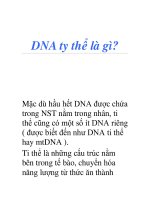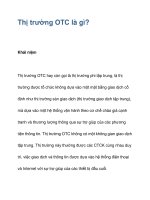Phần 51: phrasal verb là gì? pps
Bạn đang xem bản rút gọn của tài liệu. Xem và tải ngay bản đầy đủ của tài liệu tại đây (48.39 KB, 5 trang )
Phần 51: phrasal verb là gì?
1. A phrasal verb is a verb plus a preposition or adverb
which creates a meaning different from the original verb.
Example:
I ran into my teacher at the movies last night. run + into =
meet
He ran away when he was 15. run + away = leave home
2. Some phrasal verbs are intransitive. An intransitive verb
cannot be followed by an object.
Example:
He suddenly showed up. “show up” cannot take an
object
3. Some phrasal verbs are transitive. A transitive verb can
be followed by an object.
Example:
I made up the story. “story” is the object of “make up”
4. Some transitive phrasal verbs are separable. The object
is placed between the verb and the preposition. In this
Phrasal Verb Dictionary, separable phrasal verbs are
marked by placing a * between the verb and the
preposition / adverb.
Example:
I talked my mother into letting me borrow the car.
She looked the phone number up.
5. Some transitive phrasal verbs are inseparable. The
object is placed after the preposition. In this Phrasal Verb
Dictionary, inseparable phrasal verbs are marked by
placing a + after the preposition / adverb.
Example:
I ran into an old friend yesterday.
They are looking into the problem.
6. Some transitive phrasal verbs can take an object in both
places. In this Phrasal Verb Dictionary, such phrasal verbs
are marked with both * and + .
Example:
I looked the number up in the phone book.
I looked up the number in the phone book.
7. WARNING! Although many phrasal verbs can take an
object in both places, you must put the object between the
verb and the preposition if the object is a pronoun.
Example:
I looked the number up in the phone book.
I looked up the number in the phone book.
I looked it up in the phone book. correct
I looked up it in the phone book. incorrect









